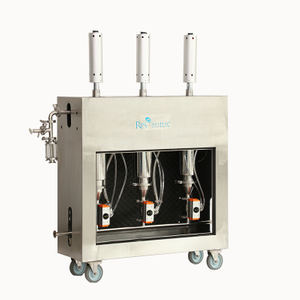What is Ultrasonic Pigment Dispersion Technology?
This technology is a key process in nanotechnology and high-end materials preparation, solving problems that traditional dispersion methods struggle with through physical means.
I. What is Ultrasonic Pigment Dispersion Technology?
Ultrasonic pigment dispersion technology utilizes the extreme physical force generated by ultrasound (typically above 20kHz) to break up pigment agglomerates and distribute them uniformly into a liquid medium (such as resin, solvent, or water), forming a stable suspension.
Its core principle is also the cavitation effect of ultrasound.
Detailed Explanation of Cavitation Effect: When high-intensity ultrasound propagates in a liquid, it generates alternating high-pressure and low-pressure cycles. In the low-pressure cycle, millions of tiny vacuum bubbles (cavitation bubbles) form in the liquid; in the subsequent high-pressure cycle, these bubbles are rapidly compressed and eventually implode (collapse).
Effects on Pigment Agglomerates:
Powerful Shear Force: When cavitation bubbles implode, they act like a "miniature bomb," generating micro-jets (liquid jets) with speeds exceeding 400 km/h in a localized area.
Shock Wave: The implosion also generates a powerful shock wave that propagates in all directions.
Overall effect: These microjets and shock waves act on pigment agglomerates, generating enormous shear forces that are strong enough to overcome attractive forces such as van der Waals forces between particles, thereby breaking down the solid agglomerates into original primary particles or achieving the desired fine particle size.
Comparison with traditional decentralized methods
Characteristics: | Ultrasonic dispersion technology | High-speed shear dispersion |
Principle | Microjets and shock waves generated by cavitation effect | Macroscopic shear force generated by mechanical rotation |
Efficiency | Extremely high, especially for nano/submicron aggregates. | Moderate, effective for macroscopic aggregation, poor effect on micrometer-scale and below. |
Final particle size | It can reach the nanoscale with a narrow particle size distribution. | Typically at the micrometer level, with a relatively wide particle size distribution. |
Energy consumption | Relatively high (but also highly efficient). | medium |
thermal effect | It generates heat and usually needs to be cooled. | Generates a large amount of heat |
Pollution risk | Low, only in contact with the probe or container | Low (but the agitator will wear down). |
Applicability | Suitable for both laboratory and industrial production, especially for high-precision, nano-dispersion. | General purpose, commonly used for pre-dispersion and coarse dispersion. |
III. Technical Advantages
Superior Dispersion: It can break down strong secondary agglomerates, resulting in smaller particle sizes and narrower particle size distributions. This is key to obtaining high-purity, high-performance colors.
High Stability: Due to the thorough separation and dispersion of particles, the tendency for re-agglomeration is reduced, resulting in suspensions with better long-term stability and less susceptibility to sedimentation and clumping.
High Efficiency and Short Processing Time: The ultrasonic dispersion process is very rapid, typically completing tasks that would take hours using traditional methods within minutes to tens of minutes.
Good Reproducibility: By precisely controlling ultrasonic power, time, and temperature, highly consistent and reproducible dispersion results can be obtained, which is crucial for industrial production.
No Media Contamination: Unlike ball milling, ultrasonic dispersion typically does not require grinding media, avoiding the risk of product contamination.
IV. Main Application Areas
This technology is widely used in industries with extremely high requirements for pigment dispersion quality.
Coatings and Ink Industry:
High-Performance Coatings: Automotive topcoats, metallic paints, etc., require excellent color, gloss, and hiding power, which depends on superior pigment dispersion.
Printing Inks: Especially nano-inks, used in high-end printing and flexible electronics.
Nanomaterial Preparation: The dispersion of graphene and carbon nanotubes is one of the most classic applications of ultrasonic technology, used to prepare conductive composite materials.
Dispersion of other nanoparticles (such as silica and zinc oxide) in a matrix.
Cosmetics Industry: Used to disperse titanium dioxide and zinc oxide nanoparticles in sunscreens, making them transparent and non-whitening.
Dispersing pigments in lipsticks, eyeshadows, and other makeup products, making them even and smooth.
Pharmaceutical Industry: Preparation of drug delivery systems, such as liposomes and nanoemulsions.
Dispersing insoluble active pharmaceutical ingredients to improve their bioavailability.
Electronics Industry: Dispersing metal powders for conductive pastes (such as silver paste and copper paste).
Preparing ceramic pastes for electronic components.
V. Technical Challenges and Precautions
Overheating Risk: Ultrasonic energy is largely converted into heat, which may cause denaturation of temperature-sensitive resins or active ingredients; therefore, a cooling system is crucial.
Probe Wear: Titanium alloy probes wear down under prolonged high-power operation, potentially introducing trace amounts of metallic contaminants. For demanding applications, periodic probe replacement or the use of special coatings is necessary.
Process Parameter Optimization: Parameters such as ultrasonic amplitude (power), time, and pulse mode need optimization for different pigment-media systems. Insufficient time leads to incomplete dispersion, while excessive time may cause excessive particle breakage or degradation.
Scale-up Effect: Maintaining uniform ultrasonic energy distribution throughout the system, scaling up from small beakers (tens of milliliters) in the laboratory to hundreds of liters in industrial production, is an engineering challenge. Flow-through ultrasonic cells are commonly used in industry to address this.
VI. Future Development Trends
Intelligentization and Automation: Integrating online particle size analyzers (such as dynamic light scattering DLS), temperature, and power sensors to achieve closed-loop feedback control and automatically adjust parameters to achieve and maintain target particle sizes.
Higher Power and Efficiency: Developing more efficient energy converters and probe designs to handle slurries with higher viscosity and concentration.
Combined with other technologies: For example, using a high-speed disperser for macroscopic pre-dispersion followed by ultrasonic fine dispersion offers both efficiency and effectiveness, representing best practice in industry.
Green Chemistry: Developing ultrasonic dispersion processes for environmentally friendly products such as water-based systems.
Summary: Ultrasonic pigment dispersion technology is a powerful and precise physical dispersion tool. Its unique cavitation effect makes it virtually irreplaceable in nanoscale and high-end applications. It is not only a powerful tool for improving the performance of traditional products (such as coatings and inks) but also a key enabling technology for promoting the development of new materials (such as graphene composites and nanomedicines). With the popularization of intelligent control, its application prospects will be even broader.



 English
English















